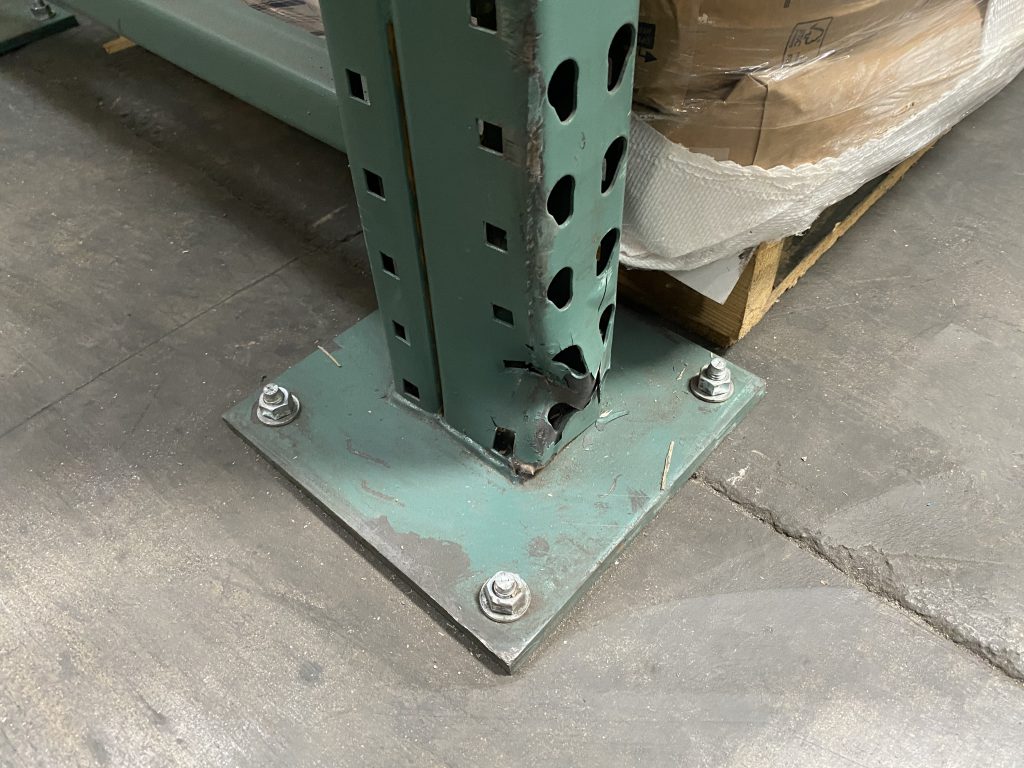
تشكل أنظمة أرفف البليت أساس تخزين المستودعات الحديثة، مما يتيح التنظيم الفعال وسهولة الوصول والاستفادة القصوى من المساحة.
ومع ذلك، مع مرور الوقت، قد تتعرض هذه الهياكل للضرر بسبب عوامل مختلفة، مثل التحميل الزائد، أو اصطدام الرافعة الشوكية، أو التثبيت غير السليم. يمكن أن تؤدي الأرفف التالفة إلى تعريض السلامة للخطر، وتعريض موظفي المستودعات للخطر، والتأثير على الكفاءة التشغيلية.
يمكن أن تؤدي عدة عوامل إلى تلف الأرفف، وأكثرها شيوعًا:
1. الحمولة الزائدة: تجاوز السعة الوزنية المحددة للرفوف يؤدي إلى الإجهاد والانحناء واحتمال الانهيار.
2. اصطدامات الرافعة الشوكية: تصطدم الرافعات الشوكية في كثير من الأحيان بأرفف البليت، مما يتسبب في حدوث خدوش أو اختلال في المحاذاة أو حتى الأضرار الهيكلية للعوارض والقوائم.
3. التحميل غير السليم: الأحمال الموزعة بشكل غير متساو أو وضع البليت غير المناسب يمكن أن يخلق نقاط ضعف في نظام الأرفف.
4. البلى: تتحلل الرفوف بشكل طبيعي بمرور الوقت بسبب الصدأ أو التآكل أو التعب، مما يقلل من قدرتها على التحمل.
5. ضعف التثبيت: يمكن أن تؤدي الرفوف غير المؤمنة بشكل كافٍ أو الفشل في اتباع إرشادات الشركة المصنعة أثناء التثبيت إلى جعل أنظمة الأرفف عرضة للتلف.
تواجه أنظمة الأرفف أنواعًا مختلفة من الضرر، يتطلب كل منها أسلوبًا محددًا للإصلاح:
1. تلف الإطار المستقيم: قد تنحني الأعمدة الرأسية أو تلتوي أو تميل بعد الاصطدام أو التحميل الزائد. وهذا يضعف الهيكل ويشكل خطرا على السلامة.
2. تلف الشعاع: الكمرات الأفقية التي تدعم وزن المنصات قد تنحني أو تتشقق أو تتشوه. وهذا يؤثر على قدرة الحامل على تحمل الأحمال.
3. تلف الدعامة: يمكن أن يؤثر التلف البسيط في الدعامات، والذي يوجد عادة على الأقواس القطرية أو الأفقية، على الاستقرار العام إذا لم تتم معالجته على الفور.
4. البراغي السائبة أو المفقودة: قد تتفكك البراغي وأدوات التثبيت بمرور الوقت أو تختفي، مما يجعل الحامل عرضة للانهيار.
تعد عمليات التفتيش المنتظمة أمرًا ضروريًا لتحديد علامات الضرر مبكرًا ومنع وقوع الحوادث. فيما يلي المؤشرات الرئيسية لأرفف البليت التالفة:
قبل البدء في أي إصلاحات، يجب إزالة جميع العناصر من الحامل التالف. وهذا يضمن بيئة عمل آمنة لفريق الإصلاح ويمنع حدوث المزيد من الضرر للبضائع. استخدم رافعة شوكية أو رافعة منصة نقالة لنقل المخزون إلى منطقة تخزين مؤقتة.
قم بفحص مكونات الأرفف التالفة بدقة، مع التركيز عليها كلاهما الضرر المرئي والخفي. يجب توثيق العوارض المنحنية والقوائم الملتوية والمسامير المقطوعة. تساعد هذه الخطوة في تحديد ما إذا كان يمكن إصلاح المكونات أم لا يجب أن تكون استبدال. إذا كان الضرر بسيطًا، فقد يكون من الممكن إصلاحه. ومع ذلك، فإن الأضرار واسعة النطاق تتطلب في كثير من الأحيان استبدال المكونات.
بناءً على التقييم، اطلب قطع الغيار إذا لزم الأمر. التأكد من مطابقة المكونات الجديدة لمواصفات الحامل التالف. قد يؤدي استخدام الأجزاء غير الصحيحة إلى إصلاح غير مناسب، مما قد يؤدي إلى حدوث أعطال في المستقبل.
قم بتفكيك الجزء التالف بعناية باستخدام الأدوات المناسبة يحب الشدات ومجموعات المقبس. قم بإزالة الحزم والقوائم التالفة دون إزعاج بقية نظام الأرفف. كن حذرًا لتجنب التسبب في مزيد من الضرر أثناء هذه العملية.
ثَبَّتَ مكونات جديدة أو تم إصلاحها بناء على تقييمك. بالنسبة للأضرار الطفيفة، قد يكون اللحام خيارًا قابلاً للتطبيق لاستعادة القوة. عند استبدال الأجزاء، تأكد من محاذاتها وتثبيتها بشكل صحيح وفقًا لإرشادات الشركة المصنعة.
بعد استبدال المكونات التالفة، قم بإعادة تجميع نظام الأرفف. قم بإجراء فحص شامل للتأكد من أن جميع الأجزاء آمنة ومحاذاتها بشكل صحيح. انتبه جيدًا للعناصر الحاملة مثل العوارض والقوائم. أي اختلال في المحاذاة أو أجزاء فضفاضة يمكن أن يؤدي إلى فشل في المستقبل.
بمجرد إصلاح الحامل وفحصه بالكامل، قم بإعادة تحميل العناصر بأمان. تأكد يتم توزيع الحمل بالتساوي ولا يتجاوز سعة وزن الحامل. إن اتباع توصيات التحميل الخاصة بالشركة المصنعة يضمن طول عمر النظام ويمنع حدوث أضرار مستقبلية.
عند إصلاح أرفف البليت التالفة، يلزم وجود العديد من الأدوات والمواد الأساسية:
يوفر إصلاح أرفف البليت العديد من المزايا التي تعزز عمليات المستودعات وتضمن السلامة على المدى الطويل:
1. فعالية التكلفة: يعد إصلاح الرفوف التالفة أكثر اقتصادا من استبدال الأنظمة بأكملها. إنه يعمل على إطالة عمر هيكل الأرفف، مما يوفر تكاليف المشتريات الجديدة.
2. تحسين السلامة: تمنع الإصلاحات المنتظمة حدوث انهيارات هيكلية، مما يضمن بيئة آمنة للعاملين في المستودعات ويحمي المخزون المخزن.
3. الكفاءة التشغيلية: تعمل أنظمة الأرفف التي يتم صيانتها جيدًا على تحسين مساحة التخزين وتحسين سير العمل، مما يؤدي إلى إدارة أفضل للمخزون.
4. الامتثال التنظيمي: الحفاظ على الرفوف في حالة جيدة يضمن الامتثال لمعايير السلامة، مما يقلل من مخاطر الغرامات أو العقوبات.
5. الاستدامة: يعمل إصلاح الرفوف على تقليل النفايات عن طريق تقليل الحاجة إلى مواد جديدة و خفض على التأثير البيئي.
6. الحفاظ على المخزون: تمنع أنظمة الأرفف المستقرة تلف المخزون، مما يقلل من فقدان المنتج ويقلل من الاضطرابات في العمليات.
تعد أرفف البليت جزءًا لا يتجزأ من عمليات المستودعات، حيث توفر دعمًا حاسمًا للتخزين المنظم والفعال. ومع ذلك، تشكل الرفوف التالفة خطرًا كبيرًا على السلامة والكفاءة.
قد يكون تحديد أولويات إصلاحات الأرفف واستبدالها يحتاج دراسة متأنية. إذا كنت ترغب في الحصول على عرض أسعار لأرفف البليت الجديدة، فلا تتردد في ذلك اتصل بنا الآن، ملكنا فريق من خبيرs جاهز لتقييم الأنسب لمستودعك.
حقوق النشر
© 2024 Jiangsu Vijing Logistics Technology Co., Ltd. كل الحقوق محفوظة.
 الشبكة المدعومة
الشبكة المدعومة
خريطة الموقع | المدونة | Xml | سياسة الخصوصية